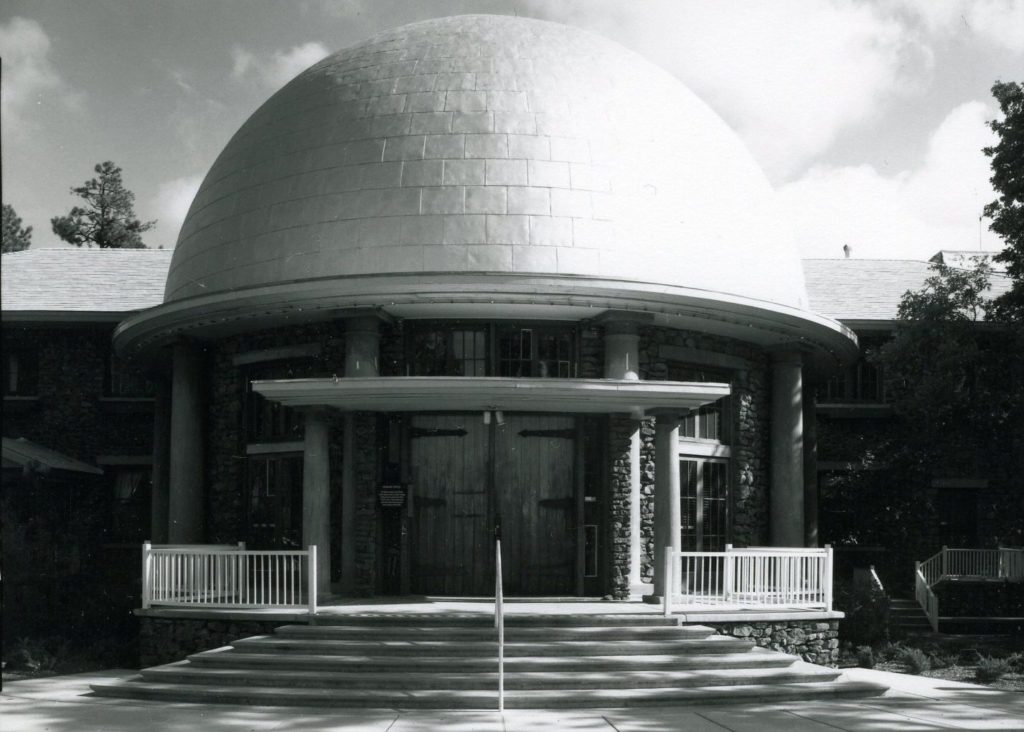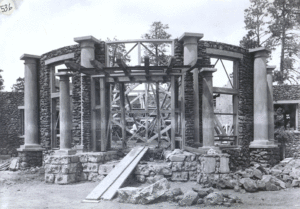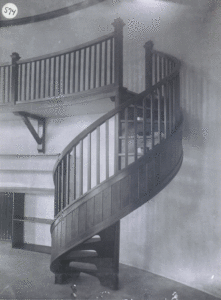
Photo: The Rotunda Museum and Slipher Building, photographed for the Historic American Buildings Survey in 1994 | Brian Grogan, Historic American Buildings Survey
Due north of the Steele Visitor Center, a venerable stone building rises three stories above the ground and one story below. Perhaps its most distinctive feature is the domed structure at its center, and the set of large (yet almost whimsically inviting) wooden doors that guard the treasures inside. On either side of the dome lie the offices of some of Lowell’s most vital and tenured staff members; including astronomers, researchers, historians, and Lowell’s current director.

The construction of the Slipher Building’s library, known today as the Rotunda Museum | Lowell Observatory Archives
Built in 1916, the Slipher Building was created to meet a growing need for office and darkroom space. The land that the Slipher Building occupies today is near where the Baronial Mansion once stood, a dwelling that was home to Percival Lowell, his wife Constance, his assistant Wrexie Leonard, his personal secretary, and two household servants. It was the last building to be constructed on Mars Hill during observatory founder Percival Lowell’s lifetime, completed shortly before his death in November of 1916. A second story and extensive attic were added in 1923, after leaks in the original single-story building’s temporary flat roof caused significant damage to the interior.
The Slipher Building’s expansive basement houses more offices and the photographic plate vault that stores the historic Pluto Discovery Plates, along with other vital images taken with the 13” astrograph used to discover Pluto. Pluto discoverer Clyde Tombaugh lived and worked in the Slipher Building when he discovered the fabled ninth planet on February 18, 1930. His apartment was located on the second floor, and is still used today as lodging for special observatory guests. Tombaugh’s office was located on the first floor, right next door to the room that housed the blink comparator.

The interior stairs of the Slipher Building library leading up to another area for books. These stairs can be seen today inside the Rotunda Museum | Lowell Observatory Archives
The interior of the Slipher Building’s dome, now called the Rotunda Museum, still contains a pair of spiral staircases that lead to a small mezzanine lined with bookshelves. These shelves hold the personal library of Dr. Carl O. Lampland, a former astronomer. During his time at Lowell, Lampland designed cameras for telescopes, measured temperatures of the planets in our solar system, and captured more than 10,000 images of planets, comets, variable stars, nebulae, and star clusters in our galaxy. Suspended from the ceiling of the dome is the Saturn Lamp, a stained-glass light fixture crafted by the Los Angeles Light Company in 1918. Other noteworthy items displayed in the Rotunda Museum are Percival Lowell’s first telescope, the blink comparator Clyde Tombaugh used to discover Pluto, and an interactive projector globe.
The Slipher Building continues to be a nexus of discovery at Lowell even today. Astronomer Nick Moskovitz and his team are currently conducting research from the building’s roof, scanning the sky for meteors each night using a LO-CAMS (Lowell Observatory Cameras for All-Sky Meteor Surveillance) station. The Slipher has also been the site of some particularly special events in the lives of Lowell staff: observatory historian Kevin Schindler’s wedding was held in the Rotunda Museum!